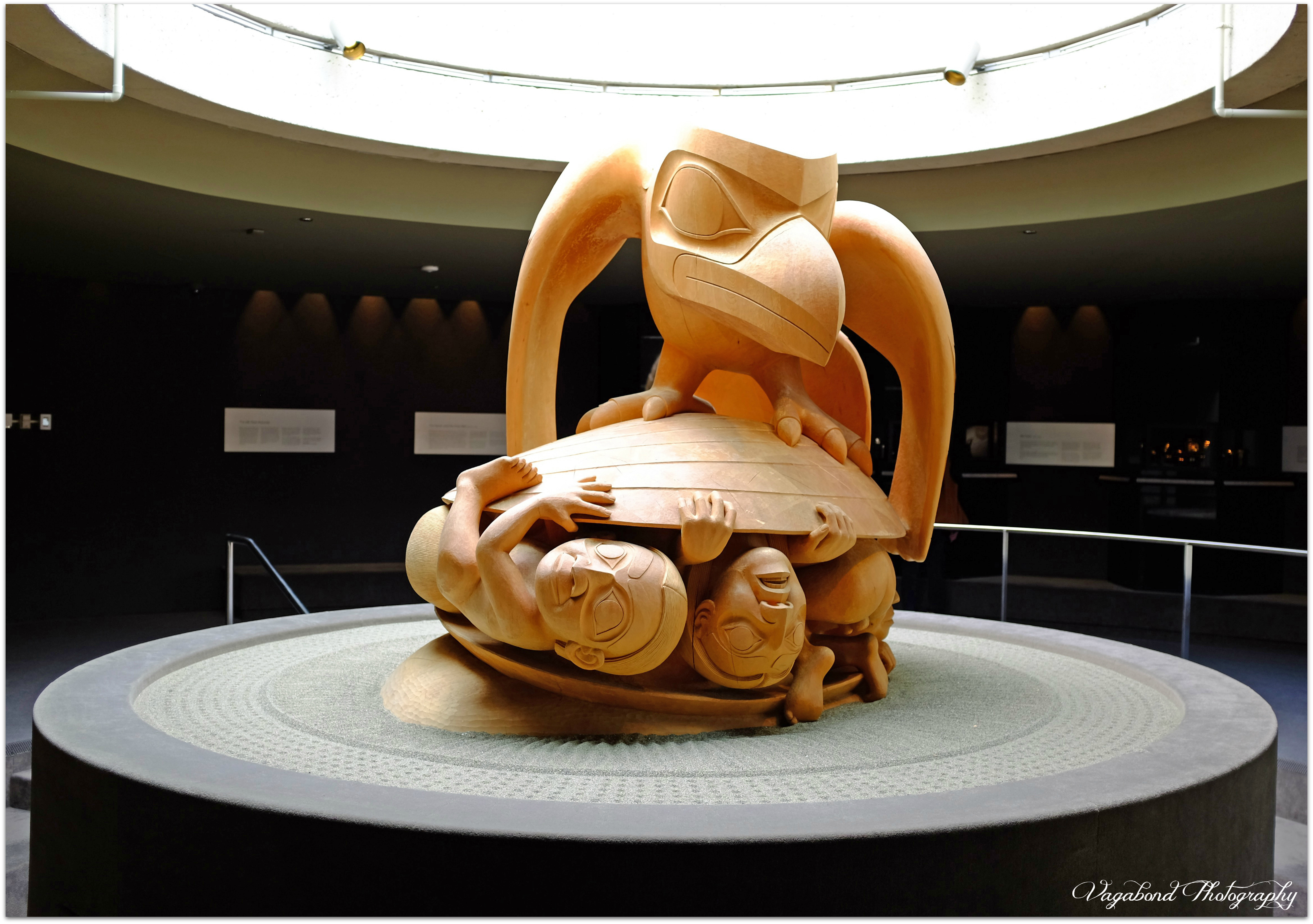Building upon last week’s post about The Museum of Anthropology, I thought I should shine a light on the oft-photographed Bill Reid sculpture, The Raven and the First Men, found deep within the museum. The stunning, mirthful, yellow cedar carving reveals the Haida legend of the creation of mankind and it literally takes your breath away when you enter the circular Bill Reid Rotunda. I admit to sitting down and staring at length at this marvellous piece of art silently bathed in sunlight. What could it mean? Why was it created? Who could make such a thing?
Artist Bill Reid, born in Victoria in 1920, hailed from a Scottish-German American father and his Haida mother born in Skidegate, Haida Gwaii. At a young age Reid spent time with his Grandfather Charles Gladstone, a carver and silversmith, and was surrounded by the work of 19th-century Haida artist Charles Edenshaw. It was this work and the work of other Haida artists that inspired Reid to continue in their footsteps. After spending time in Toronto as a CBC radio announcer, Reid returned to BC, creating jewelry at first, and then larger carvings as Parkinson’s disease afflicted, yet pushed him, to share and build upon his Haida legacy.
The sculpture you see above started out as a miniature boxwood carving inspired by Edenshaw. It tells of the Haida Legend of the Raven and the First Men: “According to Haida legend, the Raven found himself alone one day on Rose Spit Beach, on Haida Gwaii. Suddenly, he saw an extraordinary clamshell at his feet, and protruding from it were a number of small creatures. The Raven coaxed them to leave the shell to join him in his wonderful world. Some were hesitant at first, but eventually, overcome by curiosity, they emerged from the partly open clamshell to become the first Haida” – The Raven and the First Men: From Conception to Completion.
In 1973 Walter Koerner, industrialist and major benefactor of the Museum of Anthropology, commissioned Bill Reid to create a larger version of his miniature for the new museum. Built from 106 yellow cedar beams, Reid and fellow carvers George Norris, Gary Edenshaw, George Rammell, Jim Hart and Reg Davidson, began work on the carving at UBC. The carving took shape and was finally completed and then lowered by crane into what is now the Bill Reid Rotunda from a skylight above.
What many of you may not yet know is the fact that the museum was built upon the bones of World War 2 artillery gun turrets that could not be removed, but built around. Museum architect Arthur Erickson saw this as an opportunity to use the shape of one of the gun turrets to provide a home and ironic resting place for Reid’s wondrous sculpture. You can see the circular gun turret beneath the sculpture in my photo above. As Erickson’s biographer David Stouck writes “To Arthur, the glowing, golden image in yellow cedar was not only ravishing to behold but radiating with humour and sly wit. There was the Raven, the eternal Trickster figure, opening a clamshell to find the first tiny humans, one of whom is unsure about emerging and in breech-birth fashion is turning his backside to the world. More pointedly, by choosing to place on the gun turret a haunting portrayal of creation, Reid, by means of Haida narrative, was replacing the evils of imperialism with the triumphant birth of a new order.” – Arthur Erickson: An Architect’s Life
What a powerful dichotomy! Out of destruction creation rises in this wonderful, imaginative and compelling sculpture that celebrates an artist’s legacy. I know my photo does not do Reid’s sculpture justice as no photo ever captures the emotions of a place perfectly. But what I do hope is that it will inspire you to pay a visit to The Museum of Anthropology if you can. It is full of amazing stories that will leave you wonder-filled, breathless and hungry to learn more.
If you would like to see more of my MOA adventure, please pop on over to my photo website, or better yet, join me on my next adventure if you can. There is a new one around every corner here in beautiful BC!



 Hi, I’m Patti, wonderer, wanderer and photographer. During the week I’m a marketer in the publishing industry and on weekends I take to the road to explore this beautiful planet we live on.
Hi, I’m Patti, wonderer, wanderer and photographer. During the week I’m a marketer in the publishing industry and on weekends I take to the road to explore this beautiful planet we live on. 